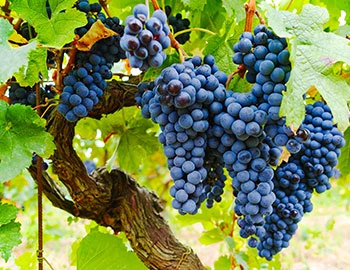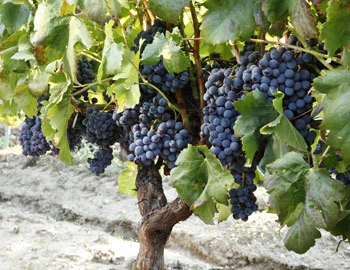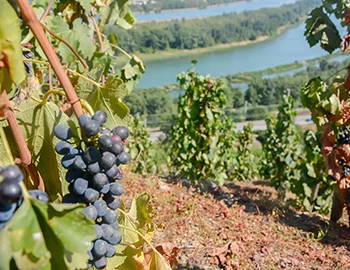
Gigondas Jucunditas 2021
AC Domaine de Cabasse, 750 ml

Description
Intense aromas of dark stone fruits, berries and Arabian spices. The skilful maturation in wood is marked by a delicate notes of dark chocolate. On the palate it convinces with a great intensity of taste and length, with ripe tannins and a peppery-juicy finish.
Attributes
| Origin: | France / Rhône / Gigondas |
| Grape variety: | Grenache, Syrah, Mourvèdre |
| Ripening potential: | 2 to 8 years |
| Drinking temperature: | 16 to 18 °C |
| Food Pairing: | Moroccan specialities, Latin American dishes, Spiced grillades, Hearty stew with pulses, Roasted lamb gigot, Salad with vegetables, pulses, pasta |
| Vinification: | fully destemmed, long must fermentation |
| Harvest: | hand-picking with simultaneous grape sel |
| Maturation: | in used barriques, in large wooden barrel/foudre |
| Maturation duration: | 12 months |
| Volume: | 14.5 % |
| Note: | Contains sulphites |
Domaine de Cabasse
This winery is situated amidst vines between the towns of Séguret and Sablet, a half-hour drive from Orange, or Châteauneuf-du-Pape. The origins of the Domaine de Cabasse date back to when the Papal seat was in Avignon. Over time, the original Italian name Casa Bassa (the house below the village) became Cabasse.
In 1990, the Swiss Häni family acquired the domaine and worked continuously to establish the reputation it enjoys today. In 2012, the Baudry family bought the entire hotel and winery and continues to manage it with the same attention to high quality.
The estate now covers 34 hectares in the municipalities of Séguret, Sablet and Gigondas and cultivates a wide range of grape varieties: Syrah, Grenache, Mourvèdre, Counoise, Carignan, Clairette and other white grape varieties. These communes are some of only 16 villages which may use their name along with the Côtes-du-Rhône Villages appellation. The plots are not overly large and are surrounded by hedges and trees that protect the vines from the cold mistral which can blow violently from the north. Otherwise, the climate in the already very broad Rhone valley is Mediterranean. The soils are mainly composed of weathered limestone with varying clay, sand and stone content.

Mourvèdre
Hot-blooded Spaniard
It cannot be hot enough for the Monastrell grape. It grows around the Mediterranean, where the summers are long and hot and the winters mild. At only 200 metres in elevation, or 80 kilometres from the coast, its grapes have problems ripening. It was likely born in the Valencia region. According to written records, it was already counted among the most important varieties in 1460. Its exact origin is thought to be the Camp de Morvedre area. From there, it migrated in the 17th century to Provence, where it was christened Mourvèdre. Its wines are deeply dark, with intense blackberry aromas, rich tannins and moderate acidity. They enter into the most beautiful harmonies with other varieties from the south, such as Garnacha, Carignan or Syrah. The Mourvèdre is the main ingredient of red wines of Bandol; it also flows into the Châteauneuf-du-Pape. On the Spanish Levante coast, it is also pressed solo.

Grenache
Grenache seldom comes alone
Spaniards and Sardinians make the Grenache contentious: both claim it originated from their country. In fact, it had already appeared in both places by the 16th century. But a large number of mutations in Spain indicates that it has deeper roots on the Iberian Peninsula. The Grenache is meaty and spicy, with a wonderful, fruity sweetness and rich aromas of blackberry, cassis, plums and pepper. Under the name Garnacha, it contributes fullness to the Rioja. In Sardinia it is called Cannonau, where it yields strong, expressive wines. But its stronghold is in France. Grenache is the star in Châteauneuf-du-Pape and streams into many other assemblages from the south. Its preferred partners are Syrah and Mourvèdre. This blend is also very popular abroad. In Australia, these wines are simply called "GSM".

Syrah
A hint of pepper
The legend stubbornly persists that the Syrah variety came from the Persian city of Shiraz. Yet, researchers have shown that it is a natural crossing of two old French varieties: the red Dureza from the Rhône Valley and the white Mondeuse blanche from Savoy. Wines from Syrah are gentle and concentrated. They smell of dark berries, violets and liquorice, and amaze with a piquant touch of white pepper. As varietal wines, they are found on the northern Rhone, as in the Hermitage or Côte Rôtie appellations, as well as in Swiss Valais. In the southern Rhône Valley, Syrah is often wedded with Grenache and Mourvèdre. In 1832, a Frenchman brought the variety to Australia, where it became the emblem of the national wine industry. There, the weightiest versions develop with typical notes of tar and chocolate.

Rhône
Rhône: northern power, southern charm
The Rhône’s source is in Valais, and it flows into the Mediterranean 800 kilometres to the south. In the last 200 kilometres of its course, it is lined with vines which yield a range of red crus that are among the most prestigious wines in the world – for example, on the spectacular cliffs of the Hermitage Mountains, or in the gravelly terraces of Châteauneuf-du-Pape. The river valley, however, is also a rich source of characterful white wines and affordable, high-quality, everyday red wines.

France
France – Philosophy in a bottle
According to French philosophy, wine should be an expression of the soil and climate. They use the word “terroir” to describe this. Terroir makes every wine different, and many especially good. French wine is regarded worldwide as an expression of cultural perfection. The French believe that humans are responsible for the quality of the berries, the vine variety for their character, and nature for the quantity. This philosophy can be expressed succinctly as: “the truth is the vineyard, not the man.”


